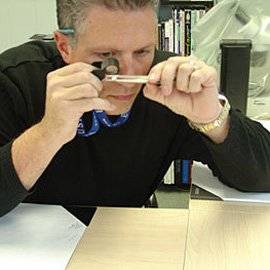How to Tell if an Opal is Real

In today's market there are synthetically produced opals sold alongside natural opals and composite opals such as doublets and triplets. This is why it has become extremely important to understand how to identify whether an opal is real or not.
What are synthetic opals?
Synthetic opals differ from naturally occurring opal stones in that the former are made entirely in the laboratory. Some individuals may choose to purchase synthetic opals for two main reasons. The first reason is that these stones are significantly stronger and more durable than naturally occurring opals. This is primarily because unlike natural opal stones, synthetic opals do not contain even trace amounts of water within them. The second reason is that of price. Since synthetic opals do not actually contain any of the precious opal compounds, they are priced substantially lower than their natural counterparts.
Synthetic opals were first created by Pierre Gilson in 1974. There are a number of compounds that can be used in the process, but the main idea is to use a polymer that allows the silica spheres within the stone to bind themselves to each other. Recently, a new form of synthetic opal has been manufactured known as Mexifire.
One of the key ways in which synthetic opals differ from natural opal stones is in their pattern. While it is possible to find natural opals with regular patterns, these are quite rare. Conversely, synthetic opals created in laboratories will almost always have an unusually regular pattern. The regular pattern witnessed in synthetic opals also create a brilliant 'play of colour' that will not be seen in naturally occurring opal stones.
Factors to be considered
Let us take a look at some factors that need close attention when determining whether an opal stone is natural, composite or synthetic:
- Body tone is one of the most important factors that need to be considered. It is important to inspect the stone and identify whether it has a pale white body tone, and also whether it has any degree of translucence or transparency. If you have found that your opal stone displays these features, it is very likely that it is real.
- Inspecting your opal stone to see if it has multiple layers is also a must. By checking the side of the stone, you may be able to tell where these layers have been glued together.
- It is also important to check the rear of the opal stone to understand whether it has a black appearance or a gray one. Triplet stones are glued to glass, black plastic or vitrolite backing. Doublets are more difficult to identify because they often incorporate quantities of colourless potch into the stone. If the seam between the backing layer and the opal is irregular, it is most likely a real stone. This is because man-made stones are flattened in the course of processing to remove such irregularities.
- If the top of the opal stone magnifies the aesthetics of the stone, it is likely to be real. Synthetic stones often appear glossy at the top.
- Be careful of purchasing imitation stones. Foil and coloured tinsel is often used to give the impression that a stone is authentic. Such lab created stones may have an amazing play of colour and an extremely regular pattern, but they are not of any particular value.
- It is also important to inspect the pattern in which the stone reflects colour. The 'play of colour' in synthetic stones is often very regular compared to real opals. Consult a professional gemmologist if you unsure on how to go about this.
- Authentic opal stones are not affected by water at all. However, composite stones that integrate multiple layers of backing may become cloudy when immersed in water for prolonged periods. Water seeps between the layers where the adhesive lies, giving the stone its cloudy appearance.
Other precautions
It is always important to purchase precious stones like opal from licensed dealers that are qualified in gemology. Insist on receiving a 'certificate of authenticity' along with your opal stone. An authentic opal stone dealer is also likely to be a member of a gemological or jeweler's association.


